by Abby Wright, CEDA
As a college Freshman, Jake Hoeppner knew he wanted to help people when they are in need. When a football injury necessitated physical therapy (PT) for Hoeppner, as a program participant, he recognized PT as “one of the last areas in the medical field where you get to spend a significant amount of time with people.”
Drawn to meaningful human interactions, Hoeppner pursued PT and recalls that throughout his graduate program, he “got to really get into what was people’s motivation for wanting to get better” and see the results of his work “helping people with all levels of dysfunction or impairment return to a pain-free, normal life.”
In 2012, Dr. Hoeppner finished his last clinical rotation at ActivePT & Sports of Rochester, then joined as its fourth physical therapist on a team that now employs 15 of them and five administrative staff. ActivePT expanded to Stewartville (inside the already existing Anytime Fitness) in 2013 as the fifth of six Active locations; Hoeppner and a colleague, Robin Heilskov, PTA, alternate in Stewartville and Rochester.
The clinic’s location inside the gym allows patients immediate access, referral, and information- and equipment-sharing between physical therapist and physical trainer, depending on the patient’s or client’s needs.
Hoeppner encourages patients to persevere through their entire PT program and to continue pushing and challenging themselves after by staying active, and a gym membership holds people accountable to that. Above all else, he recommends prevention, because a lot of issues, particularly with posture, can “creep up” over the course of years and cause neck and back pain, what he most commonly sees and specializes in.
“Just because you don’t have pain doesn’t mean you shouldn’t be doing . . . preventative treatments or exercises. If you’re in any kind of job where you’re static or sitting for a long period of time, you’ve got to be doing something to counter that.”
When problems do arise, from headaches to foot and ankle pain, ActivePT uses a handful of techniques to help people feel better. One, called dry needling, is similar to acupuncture in application but different in theory, Hoeppner explains; it is not to improve the flow of energy (qi) but to calm the nerve and release or loosen muscles. For chronically tight muscles, Hoeppner says, “It cuts into the chronic cycle of pain-inflammation, pain-inflammation, and is a good way to break it.”
Other treatment methods include instrument-assistant soft tissue mobilization (IASTM), which involves using a metal tool to put pressure on tissue to loosen it; cupping for increased blood flow; and other manual, hands-on techniques like spinal manipulation, deep tissue and muscle work, and exercise.
Exercise is what people think of when they think of PT, says Hoeppner, but it “isn’t just rubber bands and belts and telling someone to kick . . .”
Finding the right treatment option for an individual, especially with all the treatment options available, involves some trial and error.
Plenty of research exists, “but that’s just one piece of the puzzle. You gotta draw on your experience . . .” and work closely with patients to be “reflective” to possibly identify patterns of causation.
For example, headaches are complex because there are so many different types, Hoeppner explains, and migraines are the most challenging to pinpoint the cause, which could be hormones, dehydration, stress, sleep deprivation, something else, or any combination. So he advises headache patients to journal and to use mobile apps for tracking diet, habits, and other factors that may contribute to the issue.
Interestingly, Hoeppner says, research supports that people’s understanding of how the brain processes acute vs chronic pain may actually improve the pain itself. Studies show that acute pain is processed in the thalamus, but chronic pain is processed in the frontal lobe, where emotion is also processed, which may be why people with chronic pain often experience depression and anxiety.
“A small amount of pain isn’t necessarily a bad thing,” says Hoeppner, because it means the body is moving and will benefit in the long run. For someone with chronic pain, he says, the brain “sets off an alarm all the time” that he and that person need to work together to shut off, and he reminds patients that the pain can get worse before it gets better.
“With all PT, setting the proper expectations is probably the biggest thing,” he says. Everyone wants to know when and how they will get better, and that is largely dependent on how trusting and “how invested they are.”
The best part of the job, he says, is, “You’re working directly with patients when they need you the most, when they’re vulnerable–and you get to spend a significant amount of time with them.”
A couple weeks ago, a gentleman on his way out after his last session told Dr. Hoeppner that life was significantly better because of the care and treatment he received.
“It’s moments like that that remind me why I’m here.”
Thank you, ActivePT & Sports, for serving the community of Stewartville!

